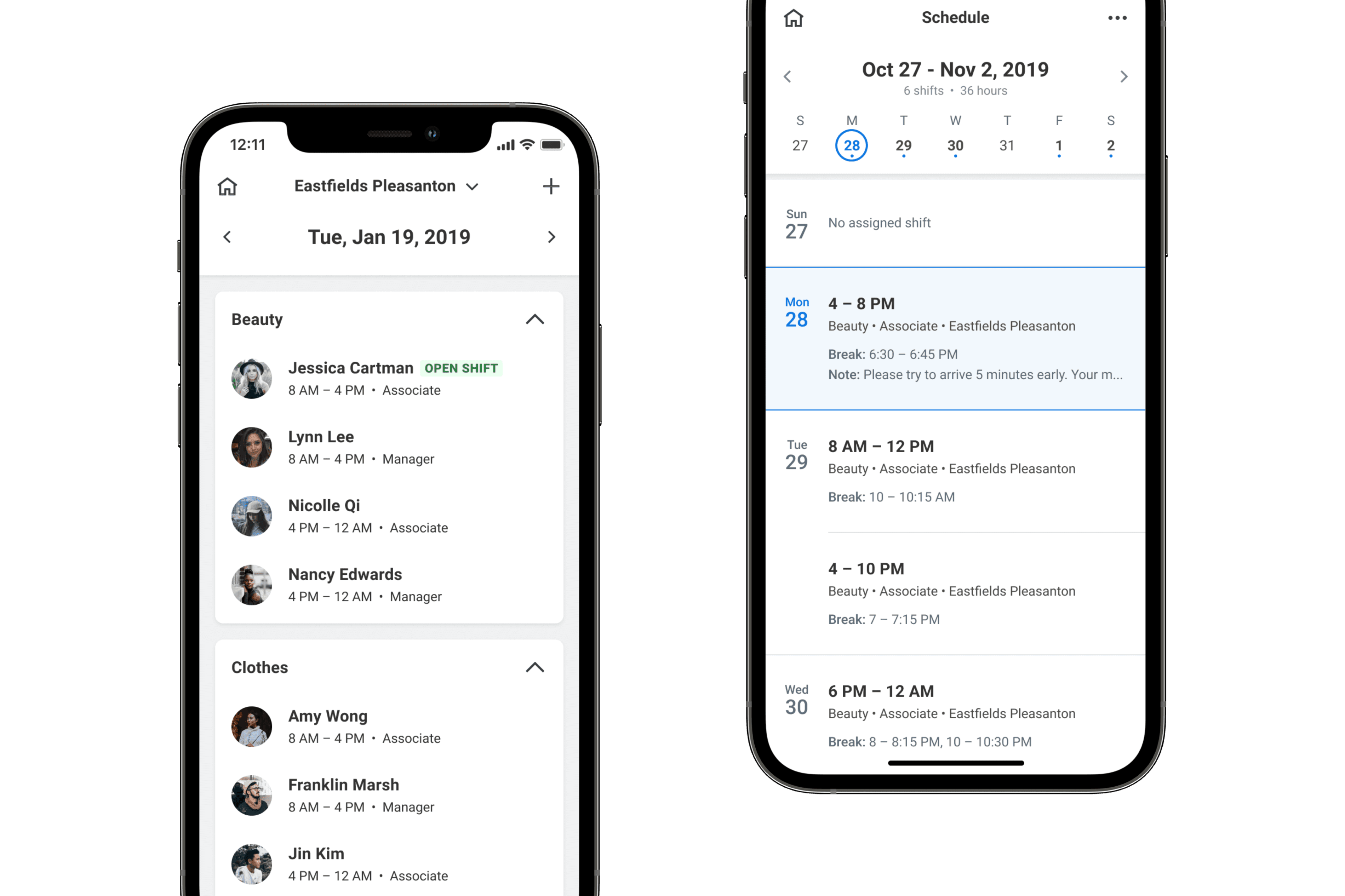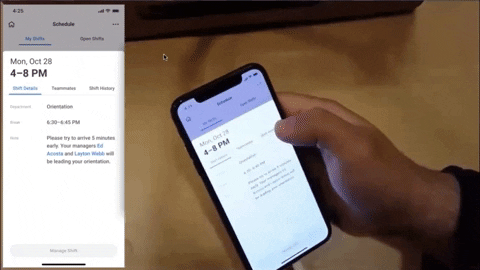Workday — Workforce Scheduling Mobile
Enabling Flexible Work Arrangements for the Frontline Workforce
I led the 0🡢1 design of Workday’s Scheduling mobile app, empowering frontline workers with more control over how, when, and where they work—while reducing the time managers spend planning schedules.
mobile
AI
0🡢1

Mobile End users (OCT 2021)
20K+
Store implementations (Oct 2021)
150+
Role
Product Designer / Mobile
Core Team
1 Product Designer / Web
1 Researcher
2 Product Managers
7 Engineers
Website
Frontline workers struggle with inconsistent schedules, understaffing, and burnout—leading to rising turnover
They're becoming more selective about where they work, placing greater value on work-life balance, job satisfaction, flexibility, and growth opportunities. Given the high cost of training new employees, businesses need ways to support flexible work arrangements to attract and retain talent in a tight labor market.
"Frontline workers are more essential than ever. As such, organizations are doubling down to ensure their needs are met by offering them tools to better manage how they work."
Mariana Santiago, General Manager, Workforce, Workday [Source]
Opportunities
Workday saw an opportunity to provide businesses with a smarter way to support their frontline workers, while closing key gaps in our product suite.
🧩
Close a product gap in Workday's flagship Workforce Management suite
Workforce Management was missing a critical scheduling component. Without it, products like Time Tracking couldn't compare scheduled vs. actual hours—creating more work for managers.
🌎
Expand into a new market with a scalable, AI-powered solution
Legacy scheduling tools were manual and not scalable. We saw an opportunity to differentiate Workday with an intelligent solution that could support even the most complex requirements for large enterprises that employ thousands of workers across hundreds of locations.
🙋♂️
Put frontline employees first
While most scheduling tools focused on reducing business costs, we aimed to improve retention and engagement by addressing employee needs around flexibility and autonomy.
Scheduling was the last piece needed to complete Workday's Workforce Management suite
Approach
We believed that supporting employee needs would ultimately drive greater business efficiency, retention, and engagement. To empower frontline workers, we prioritized giving them greater autonomy over their schedules.
At the same time, we prioritized developing Workday's first AI engine to generate optimal schedules—factoring in employee needs to improve satisfaction, while reducing schedule creation time so managers can focus on more strategic tasks.
Process
Our team operated as an independent "stealth startup" within Workday, allowing us to move quickly by avoiding existing platform constraints and processes.
We worked closely with 12 customers of our Design Partner Group (DPG), who gave us access to a massive pool of real-world data and feedback. Over four months, we conducted user interviews and field observations, identifying key challenges that shaped our vision for Workforce Scheduling.
Within a year, my design partner and I defined a blue-sky solution that took inputs on web and translated them into mobile schedules for employees. With product and engineering support, we built a successful proof of concept that greenlit our move into production.
In the following year, we iterated rapidly to meet our first customer's requirements. Meanwhile, I worked with the mobile design system and accessibility teams to align with framework and compliance guidelines before our launch.

Concept testing with frontline workers
Snapshot of UI and accessibility specs
Schedule: Surfacing critical shift details
Onsite observations showed that many organizations still use paper schedules, which frontline workers find slow and unreliable for getting updates—especially since they’re often on the go.
While designing the schedule UI, my goal was to help employees find when and where they need to be—quickly. I focused on surfacing key shift details upfront, including the time, role, and location. We prioritized a week view for our MVP, as several DPG partners plan schedules on a weekly basis.
The final core schedule UI after aligning to the mobile framework
Shift management: Prioritizing schedule flexibility
User interviews revealed that unpredictable schedules were negatively impacting many frontline workers' financial and mental health. We heard stories of managers asking employees to cancel personal plans at the last minute, workers getting less than 5 hours of sleep between back-to-back shifts, and others not getting enough hours to pay their bills.
In situations like these, employees often wanted to adjust their schedules. However, finding a replacement or covering a shift was a very slow, manual, and manager-dependent process.
To reduce friction, we introduced self-service shift management options. Employees can swap shifts with teammates or post them to an open shift board for others to cover. The AI validated shift transactions for compliance (e.g. overtime and role eligibility), speeding up the entire process and freeing up everyone's time.
An early exploration of an AI assistant facilitating a shift transaction via in-app messaging
We prioritized 'Swap Shift' and 'Open Shift' options as they provided the most flexibility for workers wanting to manage their shifts
Preferences: Personalizing schedules for employee needs with AI
To make sure employees felt heard, I needed to bridge the gap between them and our AI scheduler.
Through schedule preferences, we allow employees to specify desired work times, departments, or skills to grow—giving them an opportunity to shape their careers. We also built a feedback loop where employees could rate their schedules, helping the AI refine shift assignments and win trust.
Employees preferences influence how the AI generates new schedules
Preferences contribute to match scores, which help our AI and managers align with employee needs (Design: Jared Hirata)
A smarter clock-in/out: Integrating with Workday Time Tracking
Before we built Scheduling, our Workday Time Tracking app couldn’t detect if employees were clocking in early or late because there were no existing shift time data.
I partnered with the designer of the Time Tracking app to integrate schedules into their clock-in feature. By upgrading the system to check for timeliness and send real-time shift notifications, employees can now stay up to date and spend less time filling in timesheets.
Time Tracking cards now display contextual, real-time shift information
Extending the experience: Designing for frontline managers
Once the employee MVP was built, our next challenge was integrating it into Workday’s official mobile app. Unfortunately, legacy mobile frameworks conflicted with our bespoke build, forcing me to make several compromises that degraded the experience.
My original bespoke designs had to be reworked to use the legacy mobile framework, leading a significant increase in task completion time
As I transitioned to designing the manager mobile app, our team wanted to avoid the legacy mobile constraints. Our researcher ran a simulated study comparing my bespoke designs to compromised versions built within the existing framework. All of the framework-based tasks were at least 25% slower, with one task even performing 175% slower.
This data persuaded leadership to support our bespoke proposal, allowing us to deliver a better user experience for managers.
We were given the greenlight to use bespoke UI to create a better manager mobile app
Launch & impact
After two and a half years, Workforce Scheduling successfully launched in October 2021 to positive reception at Workday’s Conversations For A Changing World conference. At launch, we:
Deployed Scheduling to 20,000+ frontline workers across 150+ stores locations—securing our first customer
Completed Workday's Workforce Management suite with Scheduling—closing a major product gap, expanding into a new market, and unlocking a new revenue stream
Introduced Workday's first AI/ML-powered solution—positioning Workday as a competitive player in enterprise AI
Cut schedule planning time by 66%—freeing managers to focus on more strategic work
Gave frontline workers a voice in the scheduling process with a self-service experience—improving retention and engagement
"With Workday Scheduling and Labor Optimization, our more than 20,000 employees and managers can access, build, and manage schedules all in one system, allowing us to meet the needs of our workers and the business… helping both attract and retain our talent..."
Jignesh Patel, Director, Technology, Life time Inc. [Source]
The full Workforce Scheduling suite (from top left clockwise): Employee Mobile App, Manager Mobile App, Scheduling, and Labor Optimization
Reflection
Building Workday’s first AI-powered product from scratch was an incredibly challenging but rewarding experience. I’m grateful to have contributed to such an ambitious project to transform how the workforce thinks about scheduling.
While framework constraints initially limited the employee mobile app, data helped us advocate for a significantly improved manager mobile experience.
Although I was no longer at Workday to measure long-term outcomes, conversations with our pilot customers confirmed that Workforce Scheduling was already empowering their frontline workers and managers.










